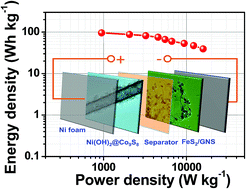Rapid microwave-assisted synthesis of high-rate FeS2 nanoparticles anchored on graphene for hybrid supercapacitors with ultrahigh energy density†
Abstract
To cater for the urgent demands of high performance energy devices, transition metal sulfides with superior electrochemical properties, especially high specific capacitance and excellent electrical conductivity, have recently drawn much attention and been widely used as a new class of electrode materials for supercapacitors. Herein, FeS2 nanoparticles anchored on graphene nanosheets (FeS2/GNS) have been synthesized by employing a facile and rapid microwave-assisted hydrothermal approach. The obtained FeS2/GNS anode displays a high specific capacity (793 C g−1 at 3 A g−1) and a superb rate capability (82% at 30 A g−1) in a wide potential range of −1.1 to 0 V (vs. Hg/HgO). An all-solid-state hybrid supercapacitor fabricated with FeS2/GNS as an anode and Ni(OH)2@Co9S8 core–shell as a cathode delivers an ultrahigh specific energy of 95.8 W h kg−1 at an average power density of 949 W kg−1 and still retains 40 W h kg−1 even at 15.8 kW kg−1 coupled with long cycling stability (86% retention after 5000 cycles), which is highly comparable with those of the recently reported iron oxide based asymmetric supercapacitors. These results render a highly promising alternative anode material for supercapacitors with high energy density.



 Please wait while we load your content...
Please wait while we load your content...